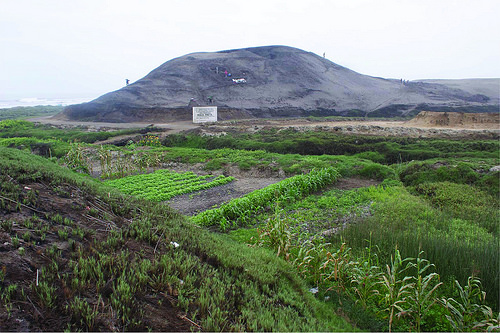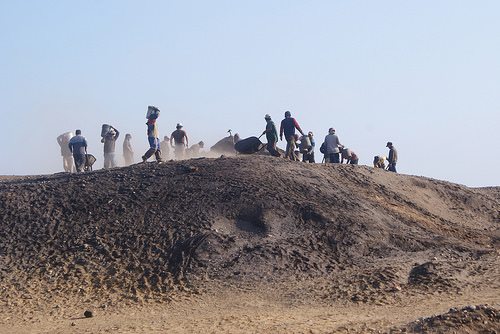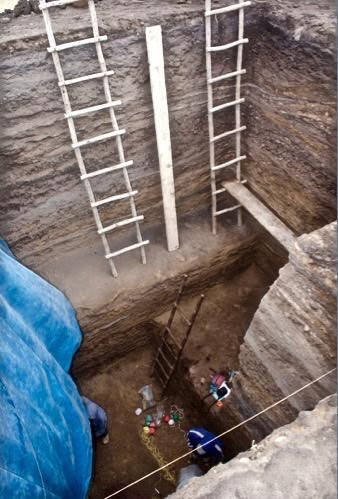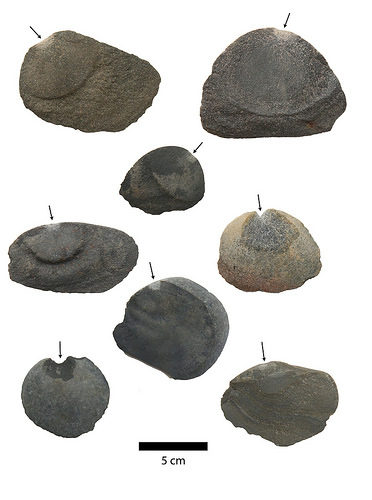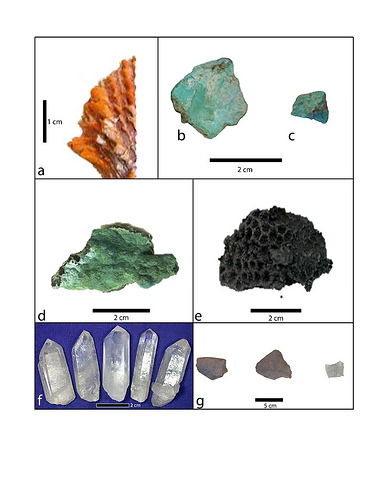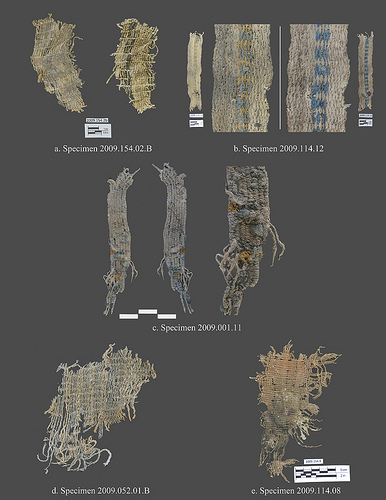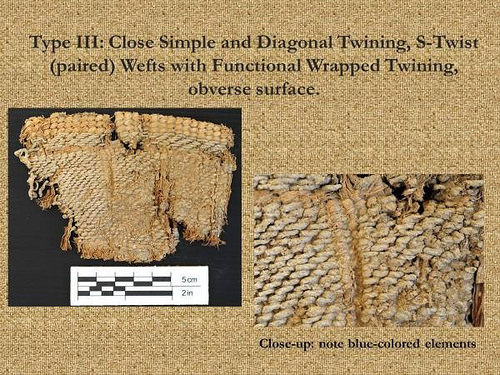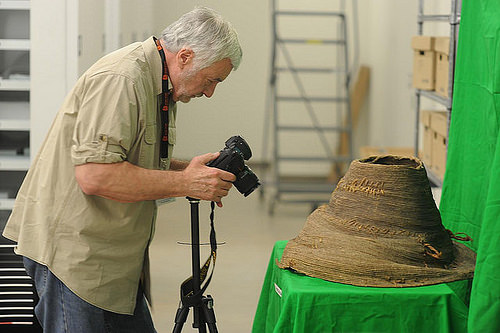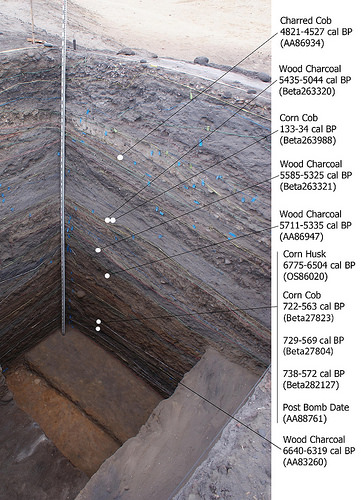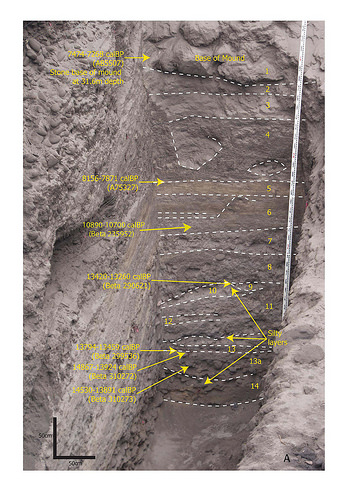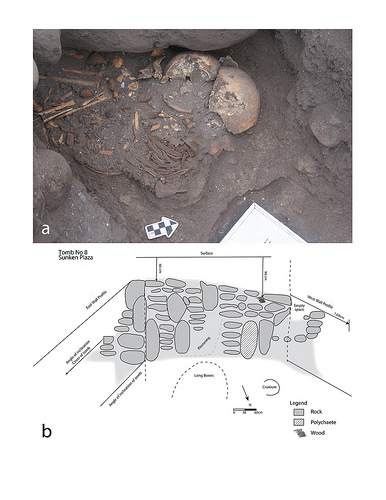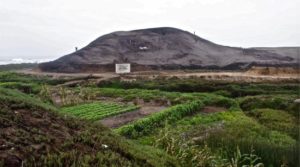
Just north of the bustling city of Trujillo, a distinctively imposing 30-meter-high mound of earth and stone overlooks the Pacific coast along the edge of the Chicama Valley. Unlike Trujillo, it is a quiet place. Agricultural fields dress its backdrop nearby. It has a name — Huaca Prieta, which, in Spanish, means “dark mound”. To the casual passer-by it strikes the impressive image of a distinctive greyish natural hill rising prominently behind the beach. But aside from its imposing physical appearance, Huaca Prieta stands apart for another very dramatic reason: within the underlying terrace that defines its foundation lies an archaeological record of human occupation that goes back as long ago as nearly 15,000 years B.P., with the astounding discovery of this very early occupation only recently coming to light.
________________________________________
Huaca Prieta means “dark mound”, which was built on a low late Pleistocene terrace between 7,800-3,500 years ago and since then used as a burial place for later cultures. Today it is used for shaman rituals. Buried in the terrace below the mound are maritime and terrestrial cultural remains dated from about 14,500 to 8,000 years ago. Courtesy Tom Dillehay
____________________________________________________
The Huaca Prieta Story
Archaeologists first began uncovering the mystery of the mound when excavations began under Junius B. Bird in 1946–1947. He and his team excavated three test pits. Among their finds were complex textiles with designs representing mythological humans, snakes, crabs and condors, as well as stone artifacts such as pebble tools and flakes. While excavating, they encountered the remains of underground structures, some of them featuring burials constructed of cobblestones and an ash-water mix. Evidence also emerged, with objects such as fish net weights and fish bones, that suggested the ancient inhabitants were fishers and gathered shellfish, with organic remains also indicating they were agriculturalists, growing beans, squash, gourds, tubers, peppers, cotton and fruit.
But the latest, and perhaps most remarkable, chapter at Huaca Prieta did not unfold until 2006, when anthropologist Tom Dillehay of Vanderbilt University began excavations and investigations of the site with the late Peruvian archaeologist, Duccio Bonavia, and a multi-disciplinary team of scientists and specialists. (Dillehay is best known for his work and discoveries at Monte Verde in Chile, where evidence of early human settlement more than 14,000 years old was found in 1975, challenging the long-held Clovis theory that suggested the first human arrival in the Americas was no older than 13,000 years ago). “I was always fascinated by the work of Junius Bird at the site and by the incredibly distinct color and form of the mound located next to the ocean,” said Dillehay of the site. “I had never seen anything like it.” Dillehay had been working on the north coast of Peru since 1976 and continued to visit the site, but a series of unanswered questions, and a tip from geologists who had previously examined the site suggesting it could possibly contain cultural material deep into prehistory, inspired him to renew investigations.
As a scientist, however, Dillehay’s interest went far beyond the prospect of discovering deep history. “The objectives were simply to better understand the economy, stratigraphy and chronology of the site with new questions and methods,” he continued. “We also planned a detailed interdisciplinary study focused on paleoecology and outlying settlement patterns in the area, including other Preceramic sites, and we wanted to produce detailed quantification and qualification of the faunal and floral remains.”
His investigations slowly made their way to accomplishing these goals. But little did he know what treasures awaited him and his team as they carefully and systematically dug their way down through the mound. “We had expected many of the findings, but we found many more and diverse items than Bird had found,” said Dillehay. The team uncovered exotic materials, as well as food and non-food remains, and countless flecks of charcoal that suggested, in the context of associated artifacts, ritual fires. “Bird thought the mound was residential, like a midden,” said Dillehay, “but it was almost exclusively ritual and mortuary.” Many other well-preserved organic remains were uncovered, including textiles, cordage, and ornate baskets. The basket remnants consisted of diverse materials, including a local reed still used by basket makers today. Some of the baskets were remarkably sophisticated, featuring segments made from domesticated cotton, colored with what was determined to be one of the oldest dyes known in the Americas. Indeed, in 2016, 6,000-year-old dyed cotton fabric was discovered. Analysis showed that it was indigotin, an indigoid dye, the earliest documented use of indigo dye to date, predating the use of indigo in Egypt by 1,500 years. In addition, stone tools, including a variety of hooks and objects likely used for deep-sea fishing, were also found.
But equally exciting was the dating of the site, particularly the lower layers.
“We were very surprised when we started getting early dates underneath the mound and especially on the south end of the mound where Bird never excavated,” exclaimed Dillehay in his correspondence with Popular Archaeology. Radiocarbon dating techniques showed human occupation as early as nearly 15,000 years ago.
__________________________________
Workers taking bucket loads of excavated sediments from a deep excavation unit to screens for sifting. Courtesy Tom Dillehay
_______________________________________________
Archaeologists working at the 30 m depth level at Huaca Prieta. Courtesy Tom Dillehay
___________________________________
An Early Society
It is no longer extraordinary to discover evidence of a human presence in the Americas before 13,000 years ago. A number of discoveries at disparate locations have attested to this — such as Blue Fish caves in the Yukon territory of Canada where archaeological remains suggest humans at about 24,000 years ago, Meadowcroft Rockshelter in western Pennsylvania, where stone tools were found to be as much as 16,000+ years old, and Monte Verde in Chile, the site of Dillehay’s excavations beginning in the 1970’s, with evidence suggesting human occupation as long ago as 18,500 B.P. These sites and discoveries name only a few that have emerged in recent years. The findings have supported the formulation of new paradigms for human migration into the Americas, adding the possibility that humans crossed by water, along coastal routes, in addition to the traditionally accepted inland routes (such as passage through the ice-free corridor from ancient Beringia after leaving Asia).
Perhaps the biggest takeaway from the Huaca Prieta investigations thus far, outside of the early dates, is the realization that a relatively sophisticated society was emerging in the region long before the earliest great civilizations were taking shape in other areas of the world. Part of the foundation of that early civilization as exemplified by Huaca Prieta was in part because of the exploitation of multiple streams of resources, combining maritime and agricultural-based economies into an integrated strategy for survival and creating an economic surplus as the basis for the early, structured, urbanized centers that followed.
“These strings of events that we have uncovered demonstrate that these people had a remarkable capacity to utilize different types of food resources, which led to a larger society size and everything that goes along with it such as the emergence of bureaucracy and highly organized religion,” said James Adovasio, co-author of the recently published study on Huaca Prieta and a world-acclaimed archaeologist at Florida Atlantic University. (It was Adovasio who conducted the pioneering work at the Meadowcroft Rockshelter in Pennsylvania, where some of the earliest evidence of human occupation in the Americas was found).
Adovasio is one of the world’s leading experts in the analysis of ancient textiles and basketry. He focused particularly on the extensive collection of basket remnants excavated at the site.
“To make these complicated textiles and baskets indicates that there was a standardized or organized manufacturing process in place and that all of these artifacts were much fancier than they needed to be for that time period,” said Adovasio. “Like so many of the materials that were excavated, even the baskets reflect a level of complexity that signals a more sophisticated society as well as the desire for and a means for showing social stature. All of these things together tell us that these early humans were engaged in very complicated social relationships with each other and that these fancy objects all bespeak that kind of social messaging.”*
____________________________________________
Various unifacial flakes from basalt and andesite cobbles, dating between ~14,500-13,500 years ago. Courtesy Tom Dillehay
_________________________________________
Above: Some of the exotic ritual offerings dated between 7,000-4,500 yrs ago: a, Spondylus fragment; b-c, turquoise fragments; d, malachite; e, Scleractinia sp. coral; f, rock crystals; g, ceramic fragments. Courtesy Tom Dillehay
____________________________________________________
Textiles: Early cotton fibers were dated to around 6,200 yrs ago. The textiles shown here are dated to 5,500-4,000 yrs ago: a, Specimen 2009.154.02.B before (left) and after (right) it was washed with hexametasulfate to remove paste and reveal dark-blue warp stripes (left: photo by the author; right: photo by Lauren Badams); b, comparison of Specimen 2009.114.12 before (left) and after (right) washing it with hexametasulfate, revealing a gold color (photos by Lauren Badams); c, Specimen 2009.001.11 (front, back, and detail) of tapestry band with gold camelid hair; d, Specimen 2009.052.01.B, which was dyed with indigo (photo by Lauren Badams); e, Specimen 2009.114.08, which has overall red color (photo by Lauren Badams). Courtesy Tom Dillehay
__________________________________________________
Basket remnants retrieved from the site were made from diverse materials including a local reed that is still used today by modern basket makers. More elaborate baskets included segments made from domesticated cotton and were colored using some of the oldest dyes known in the New World. Credit: Florida Atlantic University’s Harbor Branch Oceanographic Institute
_____________________________________________________
James M. Adovasio, Ph.D., D.Sc., co-author of the study and a world acclaimed archaeologist at FAU’s Harbor Branch, with a basket artifact from the site. Adovasio is one of the world’s foremost authorities on ancient textiles and materials such as those used in basketry. Credit: Florida Atlantic University’s Harbor Branch Oceanographic Institute
______________________________________________________
Strata in Unit 15, showing late Pleistocene and early Holocene levels and radiocarbon dates. Courtesy Tom Dillehay
___________________________________________________
Above: Profile of Unit 22, showing intact floors, fills, and radiocarbon dates. Courtesy Tom Dillehay
______________________________________________________
Above: a, photograph of burial HP08-01 on the south rim of the sunken circular plaza; b, cobblestone architecture of Tomb 8 containing HP08-01 on the rim of the circular plaza. Courtesy Tom Dillehay
________________________________________________________
Moving forward, Dillehay, Adovasio and colleagues are convinced that Huaca Prieta, and sites like it, will open new windows on our understanding of how and why remarkably early monumental civilizations arose along the Peruvian coast, in addition to a better understanding of the full chronology of civilization in Peru.
“Huaca Prieta is located on the Sangamon terrace**, which also contains later occupations all the way up to the Colonial period, so that area has the entire history of Peru there,” said Dillehay. “As for the peopling of the Americas, the early material simply adds another site to the now longer list of Pre-Clovis locales in the New World.”
__________________________
Much more information about the discoveries at Huaca Prieta and neighboring sites in Peru can be obtained by ordering the new book, Where the Land Meets the Sea: Fourteen Millennia of Human History at Huaca Prieta, Peru, now available at University of Texas Press.
__________________________________
__________________________________

